Early French Broadcasting (original) (raw)
xxxxxxxxxxxxxxxxxxxxxxx xxxxxxxxxxxxxxxxxxxxxxxxxxxxxx xxxxxxxxxxxxxxxxxxxxxxxx xxxxxxxxxxxxxxxxxxxxxxxxxxxxx xxxxxxxxxxxxxxxxxxxxxxxxxxxxxx xxxxxxxxxxxxxxxxxxxxx xxxxxxxxxxxxxxx xxxxxxxxxxxxxxxxxx xxxxxxxxxxxxxxxxxxxxxxxxxxxxxxxxxxxxxxxxxxx xxxxxxxxxxxxxxxxxxxxxxxxxxxxxx xxxxxxxxxxxxxxxxxxxxxxxx xxxxxxxxxxxxxxxxxxxxxxxxxxxxx xxxxxxxxxxxxxxxxxxxxxxxxxxxxxx xxxxxxxxxxxxxxxxxxxxx xxxxxxxxxxxxxxx xxxxxxxxxxxxxxxxxx xxxxxxxxxxxxxxxxxxxxxxxxxxxxxxxxxxxxxxxxxxx xxxxxxxxxxxxxxxxxxxxxxxxxxxxxx xxxxxxxxxxxxxxxxxxxxxxxx xxxxxxxxxxxxxxxxxxxxxxxxxxxxx xxxxxxxxxxxxxxxxxxxxxxxxxxxxxx xxxxxxxxxxxxxxxxxxxxx xxxxxxxxxxxxxxx xxxxxxxxxxxxxxxxxx xxxxxxxxxxxxxxxxxxxxxxxxxxxxxxxxxxxxxxxxxxx xxxxxxxxxxxxxxxxxxxxxxxxxxxxxx xxxxxxxxxxxxxxxxxxxxxxxx xxxxxxxxxxxxxxxxxxxxxxxxxxxxx xxxxxxxxxxxxxxxxxxxxxxxxxxxxxx xxxxxxxxxxxxxxxxxxxxx xxxxxxxxxxxxxxx xxxxxxxxxxxxxxxxxx xxxxxxxxxxxxxxxxxxxxxxxxxxxxxxxxxxxxxxxxxxx xxxxxxxxxxxxxxxxxxxxxxxxxxxxxx xxxxxxxxxxxxxxxxxxxxxxxx xxxxxxxxxxxxxxxxxxxxxxxxxxxxx xxxxxxxxxxxxxxxxxxxxxxxxxxxxxx xxxxxxxxxxxxxxxxxxxxx xxxxxxxxxxxxxxx xxxxxxxxxxxxxxxxxx xxxxxxxxxxxxxxxxxxxxxxxxxxxxxxxxxxxxxxxxxxx xxxxxxxxxxxxxxxxxxxxxxxxxxxxxx xxxxxxxxxxxxxxxxxxxxxxxx xxxxxxxxxxxxxxxxxxxxxxxxxxxxx xxxxxxxxxxxxxxxxxxxxxxxxxxxxxx xxxxxxxxxxxxxxxxxxxxx xxxxxxxxxxxxxxx xxxxxxxxxxxxxxxxxx xxxxxxxxxxxxxxxxxxxxxxxxxxxxxxxxxxxxxxxxxxx xxxxxxxxxxxxxxxxxxxxxxxxxxxxxx xxxxxxxxxxxxxxxxxxxxxxxx xxxxxxxxxxxxxxxxxxxxxxxxxxxxx xxxxxxxxxxxxxxxxxxxxxxxxxxxxxx xxxxxxxxxxxxxxxxxxxxx xxxxxxxxxxxxxxx xxxxxxxxxxxxxxxxxx xxxxxxxxxxxxxxxxxxxxxxxxxxxxxxxxxxxxxxxxxxx xxxxxxxxxxxxxxxxxxxxxxxxxxxxxx xxxxxxxxxxxxxxxxxxxxxxxx xxxxxxxxxxxxxxxxxxxxxxxxxxxxx xxxxxxxxxxxxxxxxxxxxxxxxxxxxxx xxxxxxxxxxxxxxxxxxxxx xxxxxxxxxxxxxxx xxxxxxxxxxxxxxxxxx xxxxxxxxxxxxxxxxxxxxxxxxxxxxxxxxxxxxxxxxxxx xxxxxxxxxxxxxxxxxxxxxxxxxxxxxx xxxxxxxxxxxxxxxxxxxxxxxx xxxxxxxxxxxxxxxxxxxxxxxxxxxxx xxxxxxxxxxxxxxxxxxxxxxxxxxxxxx xxxxxxxxxxxxxxxxxxxxx xxxxxxxxxxxxxxx xxxxxxxxxxxxxxxxxx xxxxxxxxxxxxxxxxxxxxxxxxxxxxxxxxxxxxxxxxxxx xxxxxxxxxxxxxxxxxxxxxxxxxxxxxx xxxxxxxxxxxxxxxxxxxxxxxx xxxxxxxxxxxxxxxxxxxxxxxxxxxxx xxxxxxxxxxxxxxxxxxxxxxxxxxxxxx xxxxxxxxxxxxxxxxxxxxx xxxxxxxxxxxxxxx xxxxxxxxxxxxxxxxxx xxxxxxxxxxxxxxxxxxxxxxxxxxxxxxxxxxxxxxxxxxx xxxxxxxxxxxxxxxxxxxxxxxxxxxxxx xxxxxxxxxxxxxxxxxxxxxxxx xxxxxxxxxxxxxxxxxxxxxxxxxxxxx xxxxxxxxxxxxxxxxxxxxxxxxxxxxxx xxxxxxxxxxxxxxxxxxxxx xxxxxxxxxxxxxxx xxxxxxxxxxxxxxxxxx xxxxxxxxxxxxxxxxxxxxxxxxxxxxxxxxxxxxxxxxxxx xxxxxxxxxxxxxxxxxxxxxxxxxxxxxx xxxxxxxxxxxxxxxxxxxxxxxx xxxxxxxxxxxxxxxxxxxxxxxxxxxxx xxxxxxxxxxxxxxxxxxxxxxxxxxxxxx xxxxxxxxxxxxxxxxxxxxx xxxxxxxxxxxxxxx xxxxxxxxxxxxxxxxxx xxxxxxxxxxxxxxxxxxxxxxxxxxxxxxxxxxxxxxxxxxx xxxxxxxxxxxxxxxxxxxxxxxxxxxxxx xxxxxxxxxxxxxxxxxxxxxxxx xxxxxxxxxxxxxxxxxxxxxxxxxxxxx xxxxxxxxxxxxxxxxxxxxxxxxxxxxxx xxxxxxxxxxxxxxxxxxxxx xxxxxxxxxxxxxxx xxxxxxxxxxxxxxxxxx xxxxxxxxxxxxxxxxxxxxxxxxxxxxxxxxxxxxxxxxxxx xxxxxxxxxxxxxxxxxxxxxxxxxxxxxx xxxxxxxxxxxxxxxxxxxxxxxx xxxxxxxxxxxxxxxxxxxxxxxxxxxxx xxxxxxxxxxxxxxxxxxxxxxxxxxxxxx xxxxxxxxxxxxxxxxxxxxx xxxxxxxxxxxxxxx xxxxxxxxxxxxxxxxxx xxxxxxxxxxxxxxxxxxxxxxxxxxxxxxxxxxxxxxxxxxx xxxxxxxxxxxxxxxxxxxxxxxxxxxxxx xxxxxxxxxxxxxxxxxxxxxxxx xxxxxxxxxxxxxxxxxxxxxxxxxxxxx xxxxxxxxxxxxxxxxxxxxxxxxxxxxxx xxxxxxxxxxxxxxxxxxxxx xxxxxxxxxxxxxxx xxxxxxxxxxxxxxxxxx xxxxxxxxxxxxxxxxxxxxxxxxxxxxxxxxxxxxxxxxxxx xxxxxxxxxxxxxxxxxxxxxxxxxxxxxx xxxxxxxxxxxxxxxxxxxxxxxx xxxxxxxxxxxxxxxxxxxxxxxxxxxxx xxxxxxxxxxxxxxxxxxxxxxxxxxxxxx xxxxxxxxxxxxxxxxxxxxx xxxxxxxxxxxxxxx xxxxxxxxxxxxxxxxxx xxxxxxxxxxxxxxxxxxx
Early Electronic Television
Early French Broadcasting
France began broadcasting 60 line television from the PTT building in Paris in early 1935 using technology developed by Rene Barthelemy. In September 1935, he developed a 180 line mechanical camera using dual Nipkow disks. Here is a short video.
Here is a technical description of the camera, from an article by Phil Hunter in the NBTVA Newsletter, Vol 36 #2:
The lighting was quoted as totalling 41 kilowatts. To keep the lighting, transmission apparatus and studio itself to a comfortable temperature a water cooled air condition unit was installed, with distinctive ship-type ventillators (see pictures below).
To change from 60 to 180 lines was agreed in April 1935...The significant problem between the two systems was the fact that the light falling on the light-sensitive cell would be 81... times weaker than in the 60 line system.
To obtain more signal, the scanning method used was a single disk with a two-turn spiral of 90 holes per turn (ie 180 holes over two turns) - the holes not required being shilded behind an 'obturator' - a second disk of radial slots that would, at any one time, mask evereything but the 'live' scanning hole. The scanning disk would revolve at 3000 rpm (ie 50 per second) to allow 25 frames per second - the obturator disc would revole more slowly depending on the number of slots provided. With 50 slots it would run at only 30 rpm. As it is offset it could be driven via a reduction gaer off the main disc's spindle and need only to be large enough to cover the scanned area. It could be relatively thick as the slots are large. This method resulted in a signal considerably stronger than a standard Nipkow disk of the same size could give.
Whichever system was used, no mention is made of how easy the camera was to pan - the bane of disk camera systems.
The photoelectric cell was quoted as a gas type, as opposed to a vacuum type.
Thus this remarkable TV system not only achieved 180 lines, with mechanically-scanned cameras on direct subject, but moreover did so without recourse to the (then brand new) secondary emission cell.
Line sync pulses were 1/100th of the line duration, with frame sync obtained by suppressing the penultimate line at the bottom of picture. Frame pulses coming from the camera's scanning disk were at 50 Hz - twice the required frequency, as the disc spun at twice frame speed. So unwanted alternate pulses were cancelled electrically by a suppression pulse generated by a separate synchronous motor-driven perforated disc.
The transmitter was described as a master oscillator type with HF amplification, the stages being:
| 1) Master oscillator having two 15 watt pentodes |
|---|
| 2) Separator stage with simlar pentodes (P15) |
| 3) First stage with two 250 watt E565 triodes |
| 4) Second stage with two 350 watt E756 triodes, anode modulated by two parallel triodes |
| 5) The output stage having two USW E1476 triodes, water-cooled, giving 2 to 3 kW to the 320 metre concentric copper feeder (3 cm central tube in 10 cm diameter 10 cm diameter outer tube). The aerial had four vertical 1-wavelenth rods, at Eiffel Tower's 4th storey. Radiated power of 1 kW gave 100 mV/m at 5 km. |
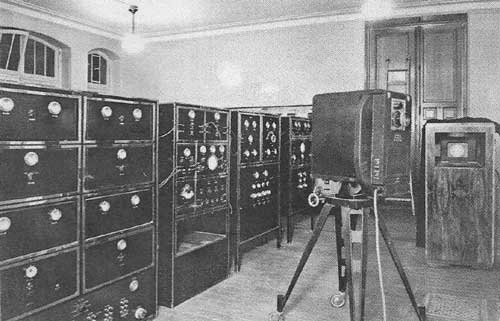

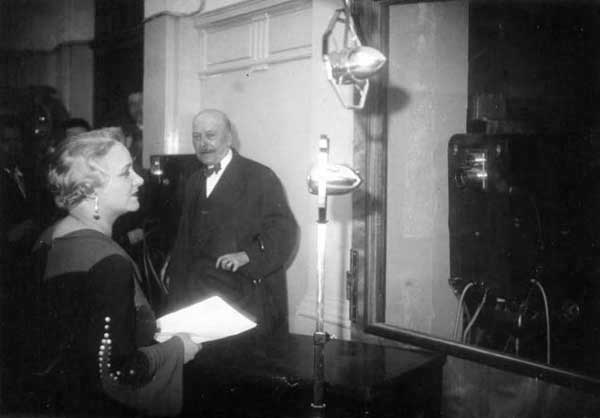
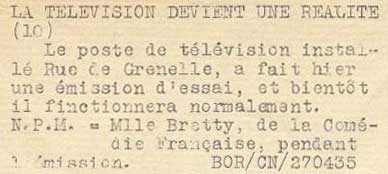
The above pictures are from April, 1935 and show the 180 line mechanical camera
A 1936 article describes an electronic receiver for the 180 line standard. An article in the January 1936 issue of Television and Short-Wave describes the French 180 line transmitter.
In 1936 the transmitter was moved to the Eiffel tower. Barthelemy experimented with a 240 line mechanical camera before moving to electronic cameras and a 455 line standard.
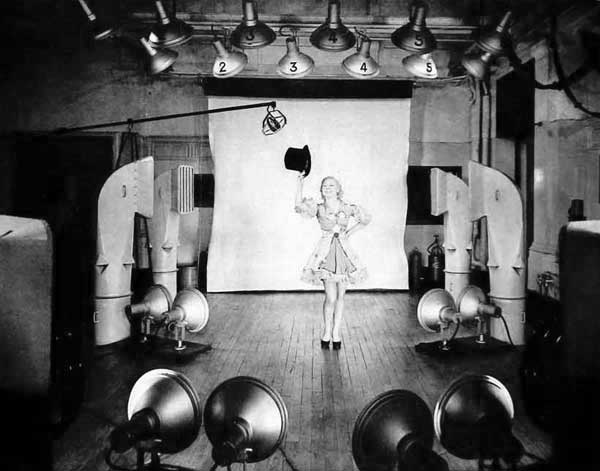
The studio at the Eiffel tower (1936). Note the air handlers.
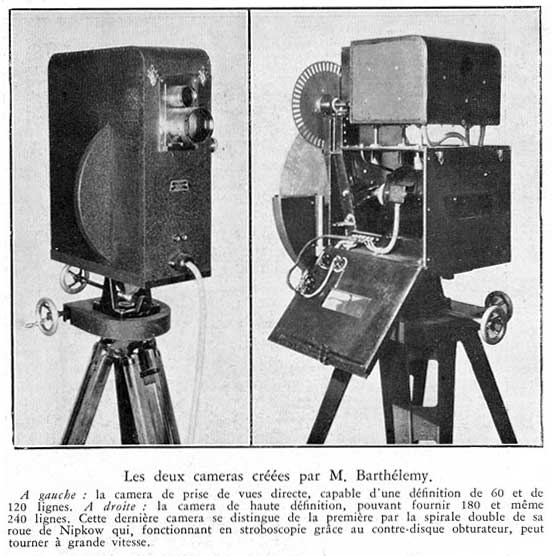
The 60/120 line camera (left) and the 180/240 line camera (right)
L'Illustration, Sept. 5, 1936
Courtesy of Mike Schultz
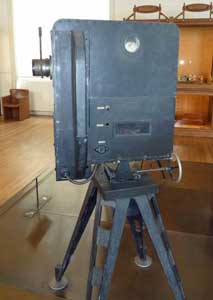 |
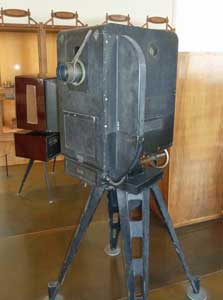 |
|---|
At the CNAM Museum, Paris
Courtesy of Jerome Halphen
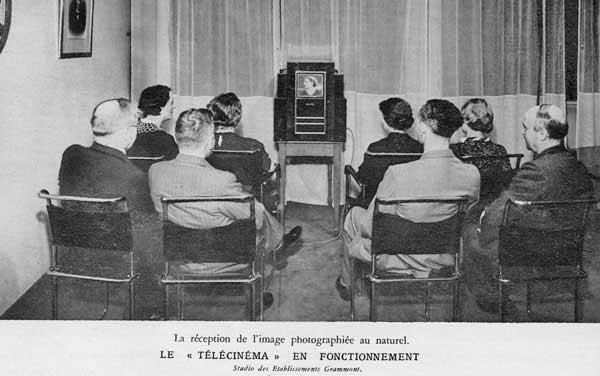
Viewers watching 180 line TV on an electronic receiver
L'Illustration, Sept. 5, 1936
Courtesy of Mike Schultz
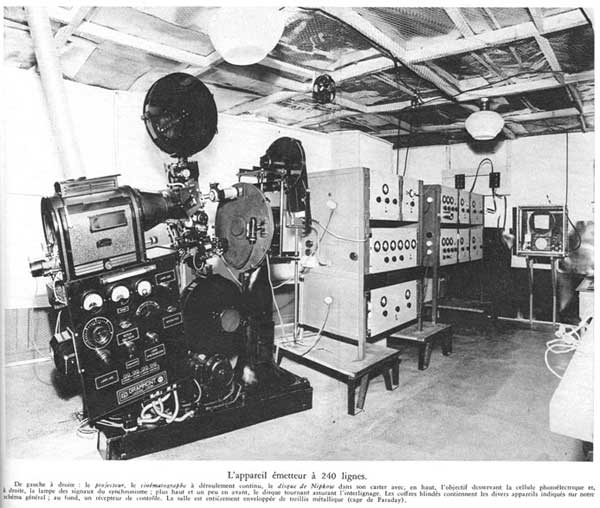
240 line film camera
L'Illustration, Sept. 5, 1936
Courtesy of Mike Schultz
The Eiffel Tower Television Installation
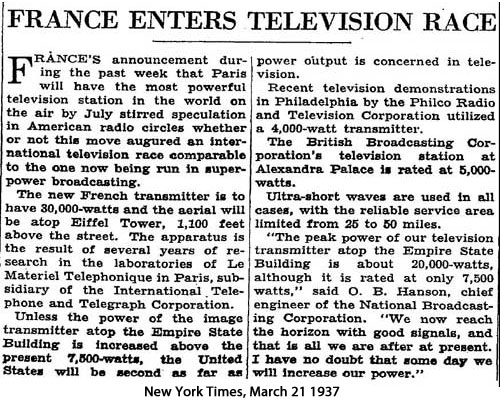 Courtesy of John Pinckney Courtesy of John Pinckney |
|
|---|---|
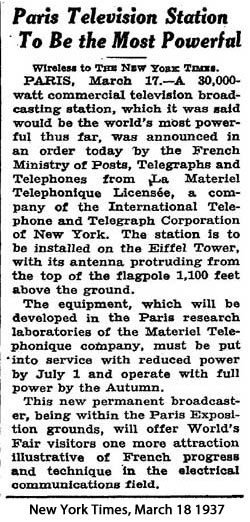 |
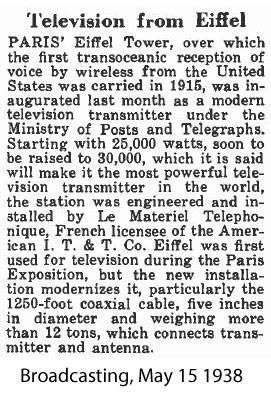 |
After Germany invaded France the Paris television station was taken over by the Nazis.